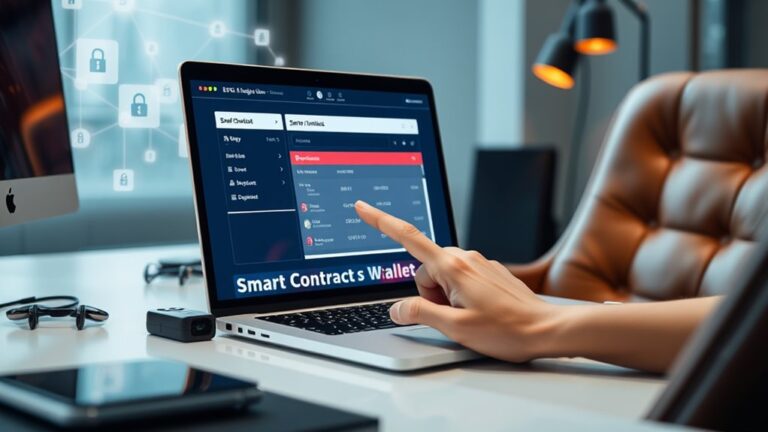
How to Transfer Crypto Between Wallets: Step-by-Step Guide
To transfer cryptocurrency between wallets, one must start by selecting the appropriate wallet type, either hot or cold. Next, check the wallet balance and verify it covers transaction fees. Confirm the recipient’s wallet address carefully to avoid errors. Execute the transfer while managing fees and enhancing security measures like two-factor authentication. Monitor for common issues, such as insufficient funds or network congestion. Following these steps guarantees a smooth transfer process and fosters understanding of wallet dynamics.
Key Takeaways
- Select the appropriate wallet type (hot or cold) based on your transfer needs and security preferences.
- Check your wallet balance and assess transaction fees to ensure sufficient funds for the transfer.
- Confirm the recipient’s wallet address for accuracy using double-checking methods or QR codes to prevent losses.
- Execute the transfer by accurately entering the recipient’s address, choosing transaction speed, and ensuring wallet compatibility.
- Monitor the transaction post-transfer for confirmation and any potential issues, such as network congestion or security breaches.
Selecting the Right Wallet for Transfer

Selecting the right wallet for transferring cryptocurrency is an essential step that can greatly impact the ease and security of the process.
Choosing the appropriate cryptocurrency wallet is crucial for ensuring secure and smooth transactions.
There are two main types of wallets: hot and cold. Hot wallets, like Exodus and Coinbase Wallet, are connected to the internet, making them suitable for frequent transactions. In contrast, cold wallets, such as Ledger and Trezor, store assets offline for enhanced security, ideal for long-term holdings.
Users also have the choice between custodial wallets, managed by third parties, and non-custodial wallets, where they maintain control over private keys.
Key features to evaluate include multi-asset support, user-friendly interfaces, and strong security measures like two-factor authentication. Understanding these options helps users make informed decisions regarding their cryptocurrency transfers. Additionally, evaluating the security measures of each wallet type is crucial for protecting your assets during transfers.
Checking Your Wallet Balance

Checking the wallet balance is a fundamental step in managing cryptocurrency assets.
By confirming available funds, users can guarantee they have enough to cover upcoming transactions, while also evaluating transaction fees associated with transfers.
Utilizing tools like blockchain explorers and wallet applications can simplify this process, providing a clear view of one’s holdings. Additionally, understanding how crypto wallets function can help users make informed decisions about their transactions and security.
Confirm Available Funds
Before transferring cryptocurrency between wallets, it is essential to confirm the available funds in the wallet. Users can check their balances through various methods.
Blockchain explorers, like Etherscan or BscScan, provide real-time insights by entering a wallet address. Mobile wallet applications, such as MetaMask or Coinbase Wallet, display current balances directly on their main screens for easy access.
For those using desktop wallet software, installed applications offer balance checks along with transaction histories. Hardware wallets allow users to securely manage their balances offline, enhancing security. Additionally, many wallets, like Coinbase Wallet, support a wide range of digital assets, making it easier to monitor diverse holdings.
Finally, paper wallets can be checked using blockchain explorers by entering a public key or scanning a QR code. Ensuring accurate balance information is vital before initiating any transfer.
Assess Transaction Fees
After confirming the available funds in a wallet, the next step involves evaluating transaction fees, which play a significant role in the overall transfer process.
Transaction fees cover the costs of processing and verifying transactions on the blockchain. These fees can vary based on several factors, including network congestion and the size of the transaction.
Different wallets and exchanges have their own fee structures, which may include fixed or variable rates. Users should also be aware of potential minimum payment thresholds that could affect their ability to transact.
To guarantee efficient transfers, monitoring fees and utilizing estimation tools can help users choose ideal times for transactions, potentially reducing overall costs. Additionally, understanding crypto lending benefits can provide insights into how fees may affect overall profitability when utilizing digital assets.
Understanding these fees is essential for effective crypto management.
Confirming the Recipient’s Wallet Address

Confirming the recipient’s wallet address is a vital step in ensuring the security of cryptocurrency transactions.
Since wallet addresses are unique alphanumeric strings, any error in entry can lead to irreversible losses.
As a result, employing address verification methods, such as double-checking the address or using tools like QR codes, is essential for safe transfers. Additionally, always use strong, unique passwords to further protect your crypto assets during transactions.
Address Verification Methods
Address verification methods are essential steps in ensuring that cryptocurrency transactions are secure and accurate. Different cryptocurrencies have unique address formats, such as Bitcoin addresses beginning with “1,” “3,” or “bc1” and Ethereum addresses starting with “0x.” Understanding these formats is vital to avoid sending funds to the wrong address.
Online verification tools can validate wallet addresses by checking their integrity and confirming they match the expected format. Furthermore, using QR codes simplifies the transaction process by reducing manual input errors.
Additionally, microtransactions can serve as proof of wallet ownership, providing a transparent verification method. By implementing these methods, users can enhance the security and accuracy of their cryptocurrency transactions.
Importance of Double-Checking
Verifying the recipient’s wallet address stands as a fundamental practice in cryptocurrency transactions, building on the importance of address verification methods.
Double-checking is essential due to the irreversible nature of crypto transactions, where mistakes can result in permanent loss of funds. Manual entry often introduces typos, which are difficult to rectify once sent. Each cryptocurrency has unique address formats, necessitating careful matching to avoid errors.
By confirming the address, users enhance security, reducing the risk of fraud and increasing confidence in transaction outcomes. Moreover, utilizing techniques such as QR codes or comparing address parts can minimize exposure to scams. Additionally, employing secure wallets can help protect against potential threats during the transfer process.
Consequently, diligent verification acts as a critical component of effective risk management in the cryptocurrency landscape.
Understanding Transaction Fees

Transaction fees play an essential role in the world of cryptocurrency, serving as the costs associated with transferring digital assets between wallets.
These fees incentivize miners or validators to process transactions and guarantee timely confirmations. The amount of these fees can fluctuate based on network demand, creating a competitive environment similar to an auction.
Transaction fees encourage miners and validators to efficiently process transactions, with costs fluctuating based on network demand.
During periods of high congestion, fees tend to increase as users vie for limited block space. Additionally, larger transactions may incur higher fees due to their size consuming more block space.
Importantly, once confirmed, transaction fees are non-refundable. Understanding these dynamics is vital for anyone looking to transfer crypto, as they can impact the overall transaction cost considerably. Moreover, users should be aware of the security tips outlined in guides to protect their assets while conducting transactions.
Backing Up Your Wallet Data
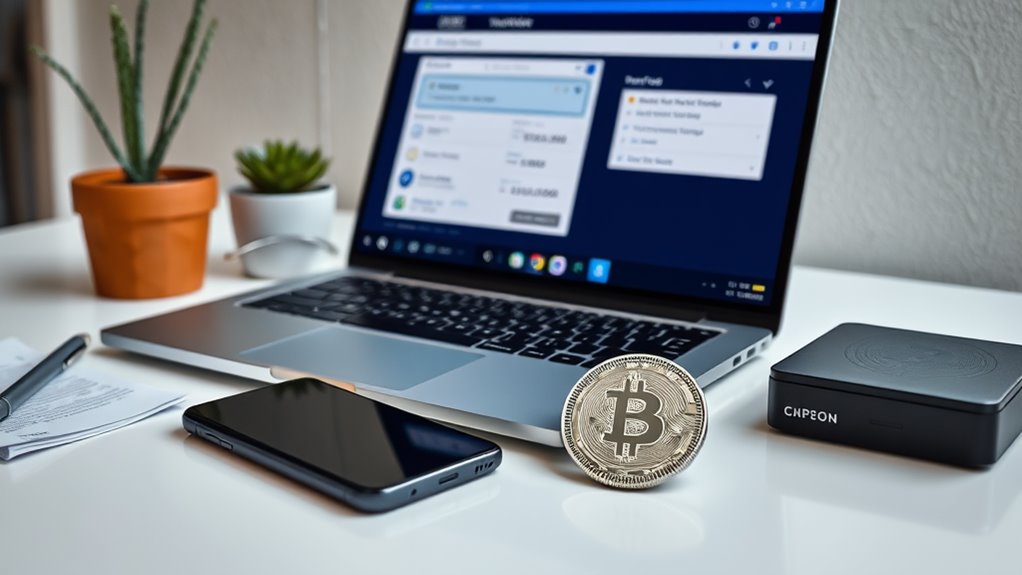
Backing up wallet data is an important step for anyone involved in cryptocurrency, as it helps guarantee the safety and accessibility of digital assets. Safeguarding wallet information protects against theft, loss, and hardware failures. It also enables recovery if a wallet becomes compromised, making it essential for managing inheritance.
Various methods exist for backing up wallet data, including storing seed phrases on metal plates, using USB drives, or uploading encrypted files to cloud services. Additionally, writing down information on paper or utilizing decentralized tools like Vault12 can enhance security. Seed phrases are particularly vital since they serve as a master key for recovering access to funds.
Maintaining regular updates, keeping multiple copies in different locations, and periodically testing recovery processes further assure that digital assets remain protected and retrievable.
Executing the Transfer Process
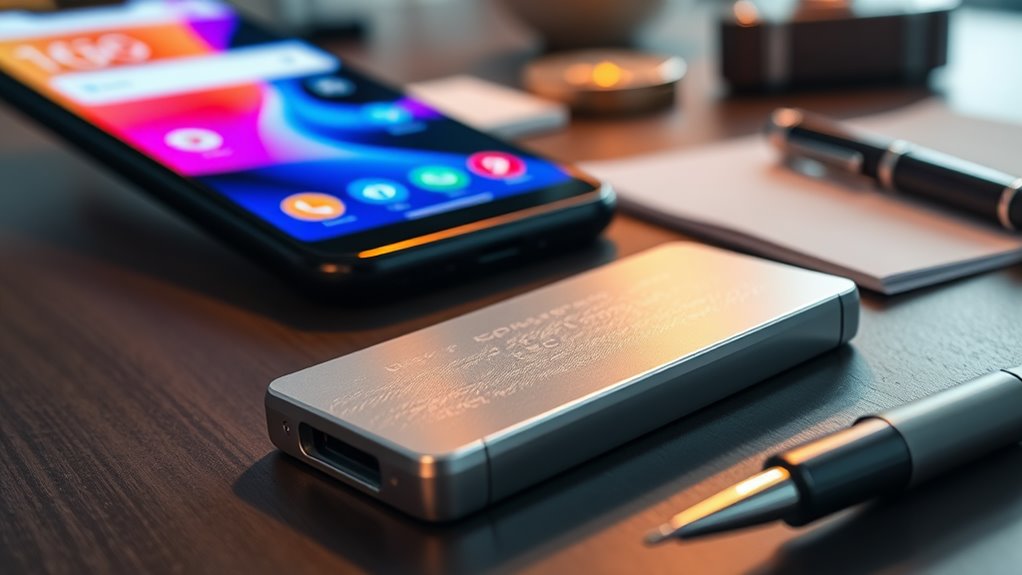
In the execution of the transfer process, the sender must first input the recipient’s wallet address accurately to guarantee the funds reach the intended destination.
Next, selecting the transaction speed is vital, as it can affect how quickly the transfer is processed, with options typically ranging from standard to expedited.
Finally, confirming all transfer details is essential before proceeding, as this step guarantees that the transaction is set up correctly and reduces the risk of errors. Additionally, ensuring strong security measures is crucial to protect the wallet and its contents during the transfer process.
Input Recipient Wallet Address
How can one guarantee a smooth transfer of cryptocurrency to the correct recipient? The first step involves accurately inputting the recipient’s wallet address.
Cryptocurrency addresses differ by blockchain; for instance, Bitcoin addresses start with ‘1’, ‘3’, or ‘bc1’, while Ethereum addresses begin with ‘0x’. It is essential to confirm that the address is an exact match, as even a small typo can result in lost funds. Addresses are also case-sensitive, necessitating precise capitalization.
Utilizing QR codes can simplify this process, reducing the risk of manual entry errors. Before finalizing the transaction, double-checking the address against the original source enhances accuracy and compatibility, ensuring that the funds reach the intended recipient without complications. Additionally, being aware of phishing attacks can help you avoid falling victim to scams that target your wallet credentials during the transfer process.
Select Transaction Speed
Selecting the appropriate transaction speed is essential for ensuring a successful cryptocurrency transfer.
Transaction speed can be influenced by several factors, including network congestion, transaction fees, and the blockchain protocol in use. During periods of high activity, delays may occur due to increased demand on the network.
To prioritize a transaction, users can opt for higher fees, which incentivize miners to process their transactions more quickly. Conversely, lower fees might result in longer wait times.
Different blockchains have varying fee structures, and some offer smart fee guides to assist users. By understanding these elements, individuals can make informed choices that align with their urgency and budget, enhancing the efficiency of their transfers.
Confirm Transfer Details
Before executing a cryptocurrency transfer, it is essential to confirm all transfer details to avoid costly mistakes. This verification process guarantees that the transaction is accurate and secure.
- Transaction Type Verification: Different cryptocurrencies have unique addresses. Verify the correct type is selected to avoid incompatible transactions, which can lead to irreversible loss of funds.
- Recipient Address Confirmation: Accuracy in the recipient’s address is critical. A single mistake can result in losing funds forever, so it is advisable to use copy and paste or QR code scanning.
- Transaction Amount Confirmation: Verify the exact amount to be sent, confirming that it aligns with your intended transaction and that sufficient balance exists in your wallet.
Managing Fees and Security Measures
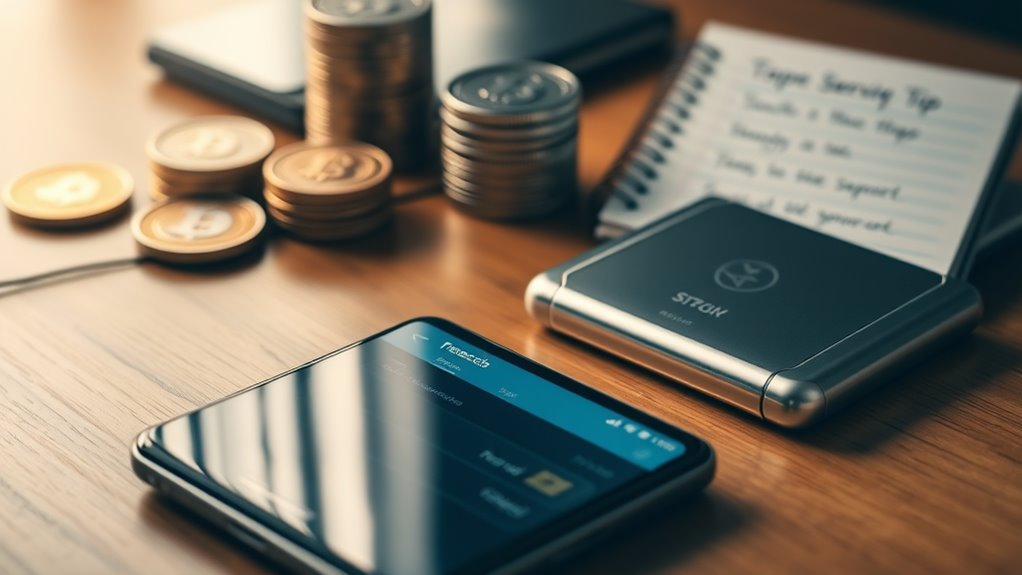
Managing fees and security measures is essential for anyone transferring cryptocurrency between wallets. Understanding network transaction fees and security protocols can greatly impact the transfer experience.
| Aspect | Considerations | Tips |
|---|---|---|
| Network Fees | Variable costs based on network demand | Transfer during off-peak hours |
| Security Protocols | Verify recipient address for accuracy | Use two-factor authentication (2FA) |
| Wallet Compatibility | Confirm wallets support the same crypto | Regularly back up wallet data |
Troubleshooting Common Transfer Issues

When transferring cryptocurrency between wallets, various issues can arise that may hinder the transaction process. Understanding these potential problems can help users navigate successfully.
- Insufficient Funds: Always verify that there are enough funds in the sending wallet to cover both the transfer amount and any associated fees.
- Incorrect Recipient Address: Double-check the recipient’s wallet address before initiating the transaction to prevent irreversible losses.
- Network Congestion: Be aware that high traffic on the blockchain can delay processing times, leading to longer wait periods for transactions to complete.
Post-Transfer Best Practices

Following the resolution of any transfer issues, it becomes important to adopt best practices for managing cryptocurrency assets post-transfer.
First, reviewing transaction details guarantees accuracy and helps avoid future complications. Keeping a record of transaction IDs is essential for tracking purposes.
Setting up notifications for incoming and outgoing transactions allows users to stay updated without constant checks. It is also critical to manage balances to reflect recent transactions, making sure that records are current and accurate.
Regular wallet maintenance includes updating software to enhance security. Utilizing strong, unique passwords and enabling multi-factor authentication (MFA) further protects assets.
Monitoring for suspicious activity and conducting routine security checks on devices and networks contributes to overall asset safety, safeguarding against unauthorized access.
Staying Informed About Wallet Security
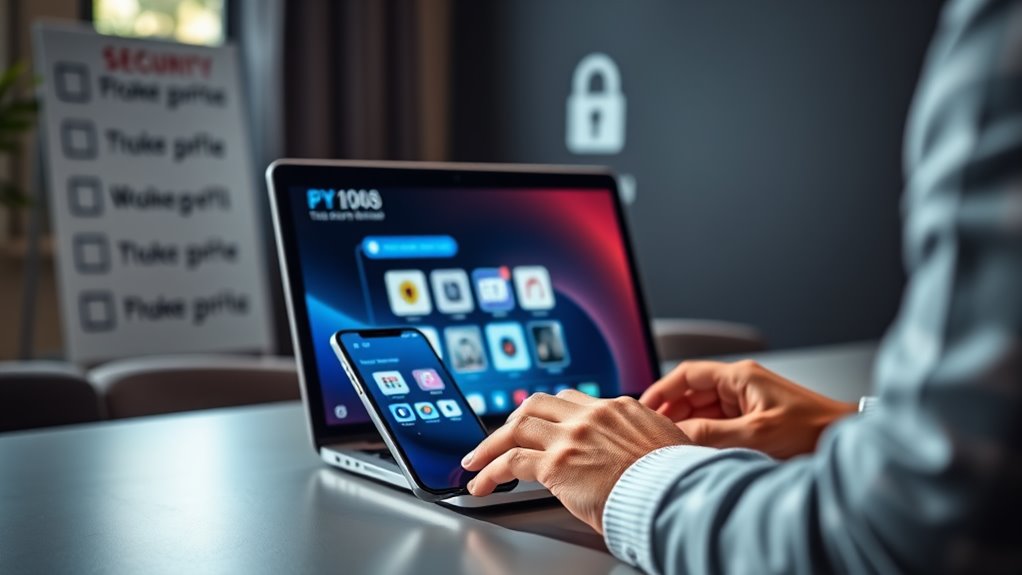
How can individuals guarantee the security of their cryptocurrency wallets in an ever-evolving digital landscape? Staying informed about wallet security is vital for protecting assets.
Here are three essential practices:
- Understand Wallet Types: Distinguish between hot wallets, which are convenient but vulnerable, and cold wallets, which offer enhanced security for long-term storage.
- Implement Key Security Measures: Utilize multi-factor authentication, regularly back up wallets, and keep software updated to safeguard against unauthorized access.
- Recognize Threats: Be aware of phishing attacks, malware risks, and physical theft, and take precautions to mitigate these dangers.
Frequently Asked Questions
What Should I Do if My Transaction Is Stuck?
When a transaction is stuck, one should consider using Replace-by-Fee to expedite confirmation, monitor network congestion, adjust transaction fees, or utilize transaction accelerators, ensuring wallet compatibility to prevent future delays.
Can I Reverse a Cryptocurrency Transaction?
Could a cryptocurrency transaction be reversed? Unfortunately, once confirmed, it is irrevocable. Mistaken transfers might only be rectified through the recipient’s goodwill, underscoring the paramount importance of accuracy in every transaction made.
How Long Do Transfers Typically Take to Complete?
Transfers typically complete within 10 minutes to several hours, influenced by factors like transaction fees, network congestion, and wallet type. Higher fees and off-peak times can expedite the process, enhancing overall transfer efficiency.
Are There Limits on Transferring Cryptocurrency Amounts?
Ironically, while cryptocurrencies promise freedom, many platforms impose transfer limits. Users face daily or weekly caps, compliance checks, and geographical restrictions, revealing that even in the digital domain, limitations often govern financial transactions.
What Should I Do if I Lose My Wallet Recovery Phrase?
Upon losing a wallet recovery phrase, one should search for backups, contact the wallet provider, transfer remaining funds, and avoid digital storage. Ultimately, the individual faces total access loss and must prioritize secure storage practices.
Conclusion
To summarize, transferring cryptocurrency between wallets is a straightforward process that requires careful attention to detail. By selecting the right wallet, verifying addresses, and managing fees, users can navigate this digital landscape with ease. With the right knowledge, transferring crypto can feel as simple as sending an email, yet the importance of security cannot be overstated. Following best practices guarantees that your assets remain safe, allowing for a more confident and secure experience in the world of cryptocurrency.








